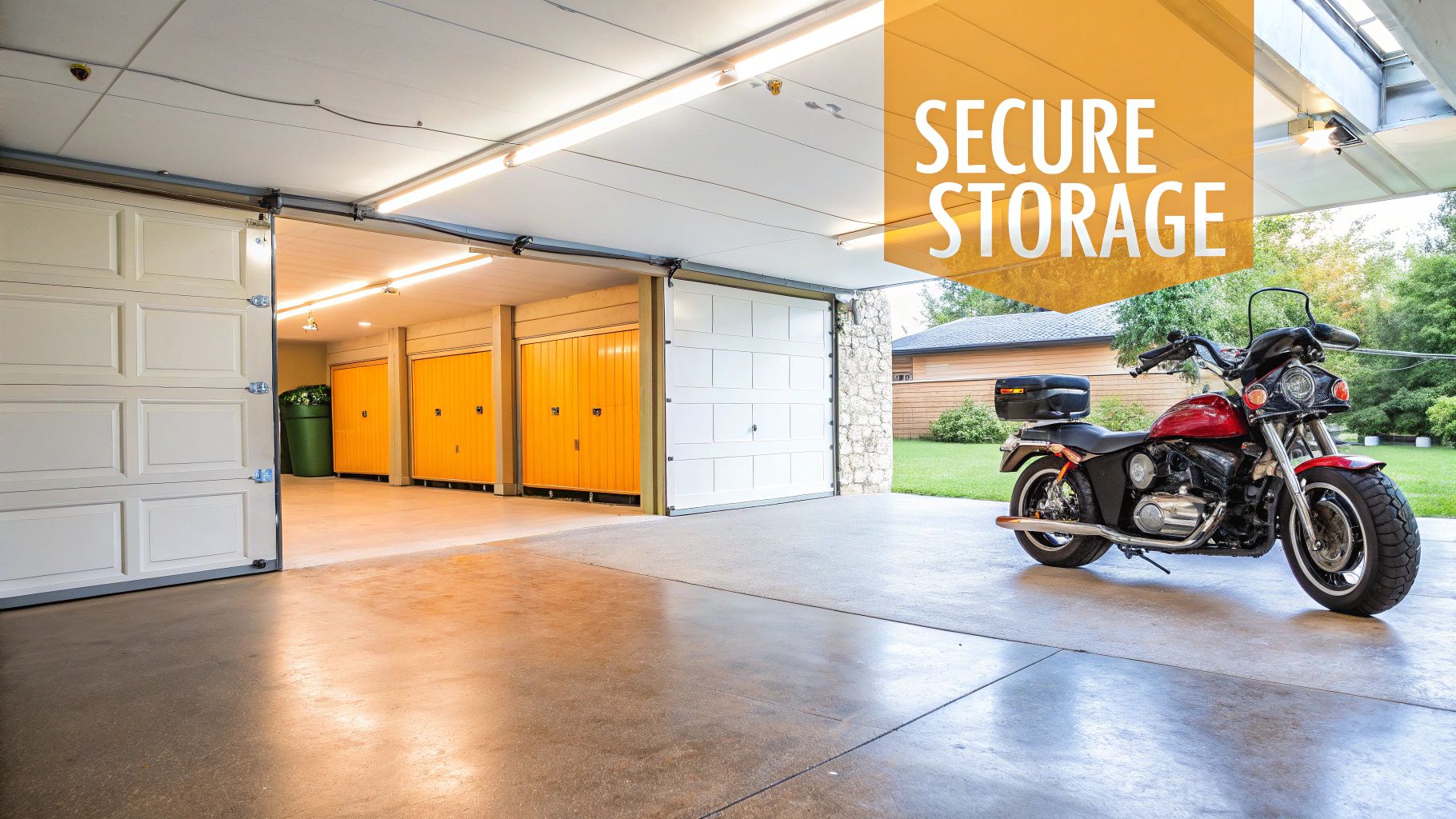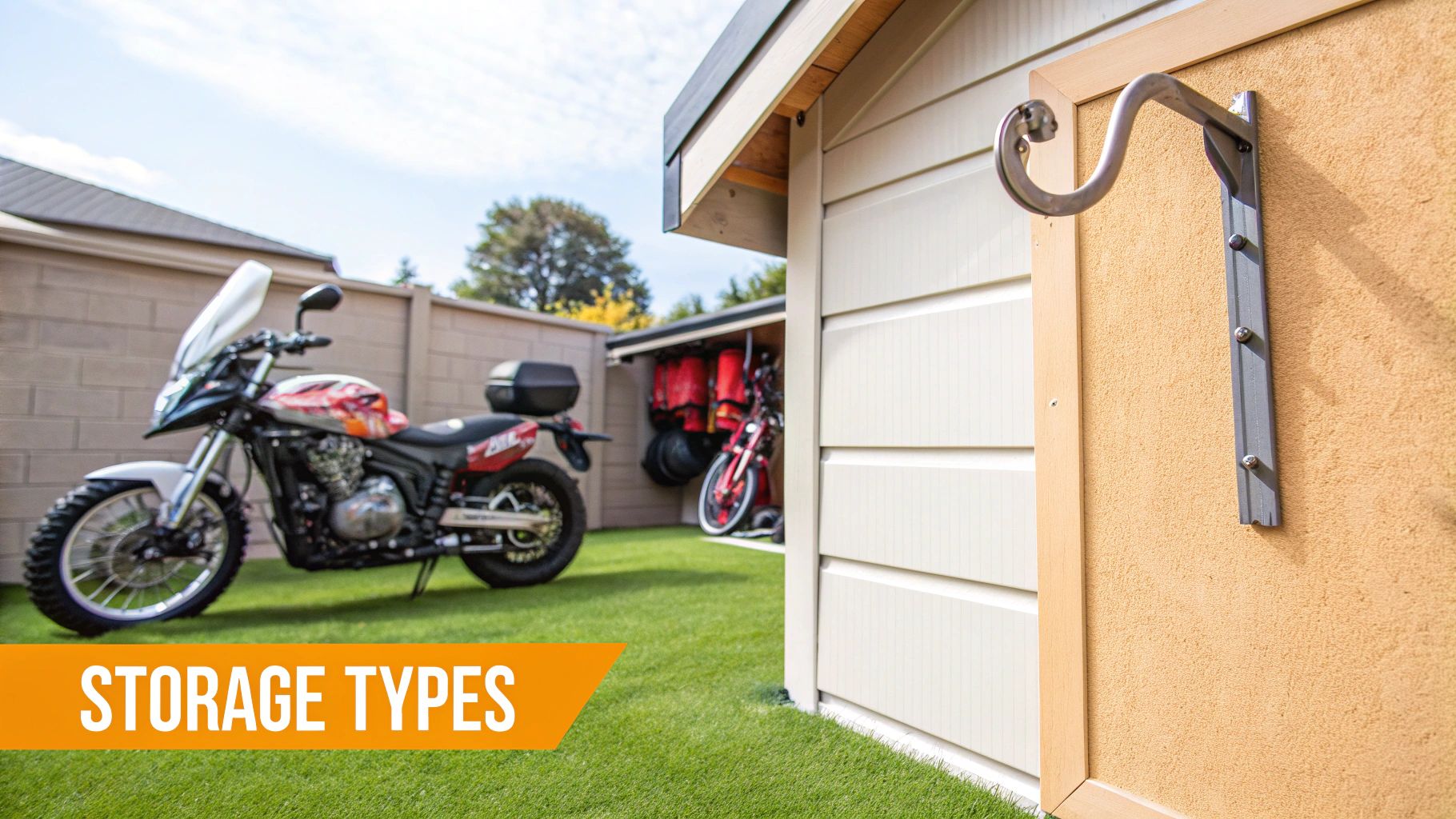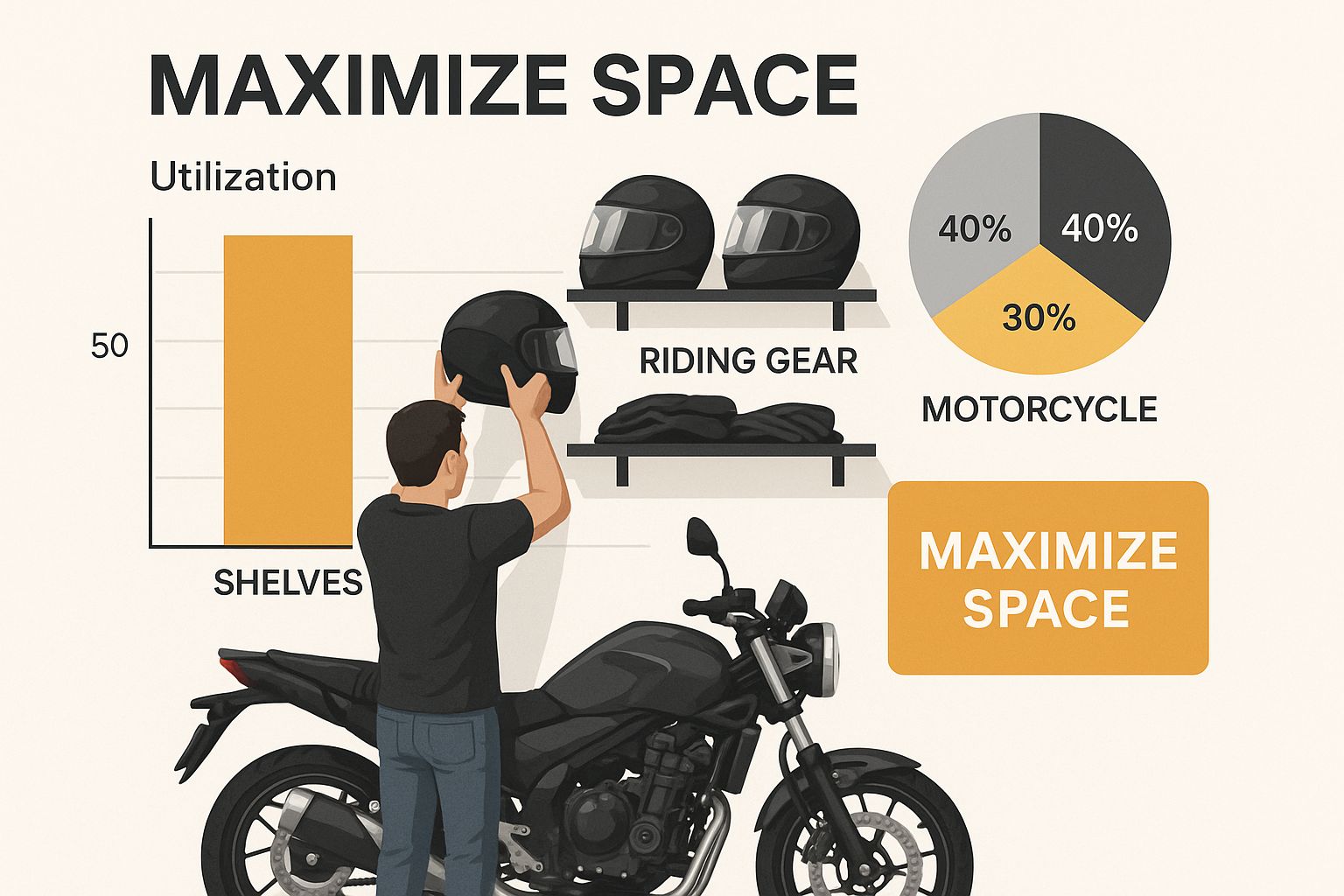Finding the right storage for your motorcycle is more than just a matter of convenience—it's about protecting your investment. The best options strike a balance between security, weather protection, and accessibility, whether you're looking at a simple cover, a dedicated outdoor pod, or a secure self-storage unit. This guide will walk you through the practical choices available to UK riders.
Why Your Motorcycle Storage Strategy Matters
Your motorcycle is usually more than just a way to get around; it’s a passion and a pretty big financial investment. Leaving it exposed to the elements or opportunistic thieves is a risk most riders just aren't willing to take.
A solid storage strategy is your first and best line of defence against the notoriously unpredictable British weather, which can quickly lead to rust, corrosion, and faded paintwork. But it's not just the rain. A proper shelter also shields your bike from UV rays that can crack seats and damage plastics over time.
Then there's security, which is a massive concern for any owner. Motorcycle theft is a persistent issue across the UK, and an unsecured bike is an incredibly easy target. A garage, a locked shed, or a dedicated storage unit is a powerful deterrent. It’s not just about stopping someone from nicking the whole bike; it’s also about protecting expensive components and accessories from being stripped.
The Real Cost of Neglect
Failing to store your motorcycle properly can cause a whole host of preventable issues that eat away at its value and performance. Think of good storage as proactive maintenance.
- Preventing Damage: Moisture is the enemy. It can creep into electrical connections, tarnish chrome, and cause rust on the frame and exhaust. A dry, well-ventilated space is absolutely essential.
- Deterring Thieves: Most thefts are crimes of opportunity. By simply securing your bike out of sight, you dramatically slash the odds of it being targeted.
- Maintaining Value: A bike that's been stored correctly will be in far better nick, holding on to more of its resale value when it's time to sell or upgrade.
A well-thought-out storage plan isn't an expense; it's an investment in your motorcycle's longevity, security, and your own peace of mind. It ensures your bike is ready to ride when you are, not a project waiting for repairs.
For riders who are tight on space at home, off-site options are a really compelling alternative. You can explore the benefits of self-storage units to see how they offer a secure, clean, and dry environment that's ideal for long-term protection.
Ultimately, the right solution keeps your machine safe, dry, and in top condition, season after season.
Getting Your Motorcycle Ready for Storage
Before you even think about tucking your bike away for a few months, getting it properly prepped is the most critical job you'll do. Seriously. Skipping these steps, especially if it's going into long-term winter storage, is just asking for trouble—think corrosion, a dead battery, and some eye-watering repair bills come springtime.
Think of it as one last, thorough service before your bike goes into hibernation.
First up, give it a proper deep clean. Get rid of all that road grime, splattered insects, and brake dust. That stuff is surprisingly corrosive and can do permanent damage to your paint and metalwork if it's left to sit for months.
Once it’s sparkling clean and completely dry, a good coat of wax will add a protective shield against any moisture in the air.
Fluids and Fuel Management
With the outside looking sharp, it’s time to sort out the internals. An oil and filter change before storage is non-negotiable. Old engine oil is full of contaminants that turn acidic over time, slowly eating away at sensitive engine parts from the inside. Fresh oil is cheap insurance.
Next, you need to deal with the fuel system to stop the petrol from going stale and prevent rust from forming inside the tank.
- Fill the Tank: Top up the fuel tank until it's almost full—about 90% is perfect. This leaves very little room for air, which dramatically reduces the chance of condensation forming and causing rust.
- Add a Stabiliser: Pour a high-quality fuel stabiliser into the petrol. It's a simple chemical that stops the fuel from breaking down, which keeps your carburettors or fuel injectors from getting gummed up.
- Run the Engine: Let the bike idle for five to ten minutes. This is crucial as it circulates the stabilised fuel through the entire system, protecting everything from the fuel lines to the injectors.
Taking a bit of time to manage the fluids now prevents the kind of silent, internal damage that happens during storage. A few quid spent on oil and stabiliser can genuinely save you hundreds in workshop bills later on.
Battery and Tyre Care
A dead battery is probably the number one headache when you pull a bike out of storage. The solution is a battery tender, sometimes called a smart charger. It's not like a standard trickle charger; a tender actually monitors the battery's voltage and only tops it up when needed. This prevents overcharging and will make your battery last much longer. Simply connect it and forget it.
Finally, don't neglect your tyres. Pump them up to the maximum recommended pressure you see on the sidewall. This simple step helps prevent flat spots from developing while the bike is stationary.
Even better, if you have paddock stands, get both wheels completely off the ground. This takes all the pressure off the rubber. These principles are pretty universal when it comes to protecting a vehicle from the elements; you can find more useful insights in this winter vehicle storage guide which covers similar ground.
Proper maintenance like this massively extends a motorcycle's life and reduces the odds of it ending up as scrap. That’s more important than ever, with the growing demand for affordable, recycled parts. The UK motorcycle salvage market was valued at USD 38 million in 2024 and is expected to keep growing, which just goes to show how much financial sense it makes to look after your bike.
Choosing The Right Storage Solution For You
Once your bike is prepped and ready for its hibernation, the next big job is finding it a temporary home. The sheer number of motorcycle storage solutions can feel a bit much, but it really just boils down to balancing your budget, the space you have, and how much security you genuinely need. Let’s walk through the most common options to help you land on the right choice.
With our towns and cities getting more congested, more of us are turning to two wheels for commuting and fun. The UK's two-wheeler market, valued at a hefty USD 880 million in 2024, really drives this point home. This boom in biking naturally leads to a bigger demand for decent storage. You can discover more insights about this trend and how it's shaping the market.
At-Home Motorcycle Storage Options
For most riders, keeping their bike at home is just the easiest and most convenient option.
The simplest place to start is with a high-quality, breathable motorcycle cover. And I don't mean a basic dust sheet. A proper cover is your first line of defence against moisture build-up, UV rays that fade your paintwork, and the wandering eyes of opportunist thieves. Honestly, it's the bare minimum every rider should have, even if the bike is tucked away in a garage.
If you’ve got a bit of garden or driveway to play with, a portable garage or a dedicated motorcycle shed is a massive step up.
- Portable Garages: These are usually fabric shelters stretched over a metal frame. They do a great job of keeping the weather off but their security can be a bit hit-or-miss. If you go down this route, look for one with a solid frame that you can properly anchor to the ground.
- Motorcycle Sheds: Available in metal or wood, these are a much more permanent and secure solution. A solid metal shed, kitted out with a beefy, insurance-approved lock and a ground anchor installed inside, becomes a serious deterrent for any would-be thief.
Whichever at-home option you settle on, good ventilation is absolutely crucial. A completely sealed-up space is a breeding ground for damp, which is a one-way ticket to rust and corrosion, especially during our cold, wet UK winters.
Getting your storage space organised is just as important as the structure itself. This handy infographic shows you how to manage your gear and make the most of the space you've got.
As you can see, using vertical space with shelves for helmets and other kit keeps everything tidy and stops you from accidentally knocking things into your bike.
Off-Site And Professional Storage Units
If you're tight on space at home or just want the absolute best protection money can buy, a professional self-storage facility is a fantastic choice. These places offer a secure, clean, and dry spot for your bike, often with the added bonus of 24/7 CCTV.
The biggest draw for many is the option of a climate-controlled unit. This is the gold standard. It keeps the temperature and humidity rock-steady, which is perfect for protecting a classic or high-value bike from any risk of corrosion. It effectively takes the unpredictable British weather completely out of the picture.
It's usually the priciest option, but for a prized machine, the peace of mind it brings is often well worth the cost.
Comparing Popular Motorcycle Storage Solutions
To make things a bit clearer, here’s a quick breakdown of the common options, comparing what they offer in terms of security, weather protection, and cost for UK riders.
| Storage Type | Security Level | Weather Protection | Typical Cost | Best For |
|---|---|---|---|---|
| Motorcycle Cover | Low | Moderate (UV, dust, light rain) | £20 – £100 | Basic protection for bikes stored in a garage or secure area. |
| Portable Garage | Low to Moderate | Good | £150 – £400 | Riders with driveway/garden space needing good weather protection on a budget. |
| Motorcycle Shed | Moderate to High | Excellent | £300 – £1,000+ | Homeowners looking for a secure, permanent at-home solution. |
| Self-Storage Unit | High | Excellent | £50 – £150 / month | Renters or those without home space who need top-tier security. |
| Climate-Controlled Unit | Very High | Ultimate | £100 – £200+ / month | Owners of classic, custom, or high-value bikes needing total protection. |
Each option has its place, and the "best" one really depends on your bike, your home situation, and how much you're willing to spend for that extra layer of security and protection.
Essential Security for Your Stored Motorcycle
Just sticking a roof over your motorcycle is only half the battle. If you really want to protect your pride and joy, you need to think in layers—layers that make your bike a frustrating, time-consuming target for any would-be thief. This is doubly true if you’re in a city where secure off-street parking is a rare luxury.
Even with a recent downturn in new registrations, like the 17.1% drop the British motorcycle market saw in early 2025, the demand for solid storage solutions hasn't gone anywhere. If anything, existing owners are more focused than ever on keeping their bikes safe. Learn more about these market trends.
This means you’ve got to move beyond a simple cover and a disc lock. Your security strategy needs to start from the ground up.
Building a Foundation with Anchors and Chains
The absolute cornerstone of any physical security setup is an immovable object. For a motorcycle, that means a ground anchor or a wall anchor. These aren't just bits of metal; they're heavy-duty, professionally rated bits of kit that you bolt directly into solid concrete. Once installed, you have a rock-solid point to secure your bike to.
When you're shopping for hardware, keep an eye out for the 'Sold Secure' rating. This is an independent testing standard that insurance companies know and trust. A Sold Secure Gold or Diamond rated anchor, chain, and lock combo isn’t just a powerful visual deterrent; it’s often a flat-out requirement to validate your theft insurance. A massive, high-quality chain is completely useless if it’s just looped around a wooden post that someone can saw through in minutes.
The real goal here is to make stealing the bike as noisy, difficult, and time-consuming as humanly possible. A thief is after a quick, silent getaway. A Sold Secure chain bolted to a ground anchor is the polar opposite of that.
For a deeper dive into protecting your investment, our guide on how to store your vehicle safely offers plenty more practical advice.
Adding Electronic Layers of Defence
Once your physical security is locked down, it’s time to bring in the electronics. Think of these as your secondary line of defence, designed to alert you to trouble and, if the worst happens, help you get your bike back.
Here are the main players:
- Alarm Systems: A decent motion-sensitive alarm will scream its head off if the bike is tampered with. This is fantastic for drawing unwanted attention, especially if your bike is in a residential garage or a shared parking area.
- GPS Trackers: These are small, discreet devices you can hide somewhere on your motorcycle. If it gets stolen, you can track its location in real-time on your phone, which massively increases the odds of recovery.
To really fortify your stored motorcycle, it’s worth consulting a comprehensive guide to vehicle security systems, as many of the principles apply just as well to bikes. Combining a hefty physical lock with an alarm or a tracker creates that multi-layered defence that makes your bike a much, much less appealing target.
Maintaining Your Bike During Long-Term Storage
Tucking your motorcycle away for the season isn't quite a "set it and forget it" job. Think of long-term storage as a state of hibernation, not abandonment. A few simple, periodic check-ins are absolutely key to making sure your bike stays in prime condition and is ready to fire up the moment you are.
These quick maintenance checks are all about preventing small issues from spiralling into costly workshop repairs. Ignoring your bike for months can lead to a dead battery, seized brakes, or even damage from moisture and pests. Honestly, a five-minute check every few weeks is all it takes to keep it healthy.
Your Quick Storage Check-In Routine
The goal here isn't to perform a full service; it's to spot trouble early. I always set a recurring reminder on my phone to pop in and see my bike every two to three weeks.
Here’s what I look for:
- Battery Tender Status: First things first, I glance at the battery tender. I make sure the lights indicate it's working correctly—usually, a solid green light means the battery is fully charged and being maintained. A flashing or red light could signal a problem with the battery or the tender itself, so it's the first thing I check.
- Tyre Pressure: Give the tyres a quick squeeze or, even better, check them with a pressure gauge. They will naturally lose some air over time. Topping them up if they feel soft is a simple way to help prevent nasty flat spots from developing.
- Pest and Moisture Inspection: I have a quick look around and under the bike. I'm checking for any signs of pests, like droppings or nests, particularly in the airbox or exhaust if they weren't plugged. I also scan for any damp patches on the floor or condensation on the bike itself, which could point to a problem with the storage environment.
A proactive approach to storage maintenance is crucial. These small steps ensure your bike remains an asset, not a liability that needs fixing before you can even think about riding it.
Checks for Very Long-Term Storage
If your bike is going to be stored for six months or more, adding one more simple task to your routine is a great idea. Every month or two, just gently rotate the wheels by hand. This simple action changes the pressure point on the tyres, offering the best possible defence against developing permanent flat spots on the rubber.
This process is a key part of what you should consider before storing your vehicle long-term. For some general insights on power management and keeping your vehicle ready, you can also check out these tips on preventing battery drain. These simple but effective checks are the final piece of the puzzle for successful motorcycle storage solutions, guaranteeing a hassle-free start to your next riding season.
Got Questions About Motorcycle Storage? We've Got Answers
Even with the best plan, you might still have a few questions buzzing around your head about the finer details of motorcycle storage. Let's be honest, getting these things right can be the difference between a happy reunion with your bike in spring and a season-opener full of headaches.
Think of this as the final checklist before you tuck your bike away. It’s just as crucial as the regular maintenance you carry out all summer. Here are a few of the most common queries we hear from UK riders, with some straightforward, no-nonsense answers.
Do I Really Need to Tell My Insurer Where I’m Storing My Bike?
In a word: yes. You absolutely have to. Your insurance premium is calculated based on risk, and where your bike spends its nights is a massive part of that equation. A locked garage, a secure storage unit, or even just parked on the street under a cover – your insurer needs to know the exact details.
It might seem like a small detail, but giving them the wrong information (even accidentally) could give them grounds to void your policy if you need to make a theft claim. On the other hand, being upfront can actually work in your favour. Many insurers offer a nice little discount for approved security measures, like using a ‘Sold Secure’ ground anchor or keeping your bike tucked away in a locked, secure building. Honesty often pays.
Is a Breathable Motorcycle Cover Worth the Money?
It’s not just worth it; it’s essential, especially with our notoriously damp UK climate. Grabbing a cheap plastic tarp from the hardware shop is one of the worst things you can do. It’s a moisture trap, plain and simple. Condensation gets locked in against your bike, leading to a whole host of problems.
Before you know it, you've got rust blooming on your metalwork, corrosion creeping into your electrics, and even mildew making a home on your seat.
A quality breathable cover is a small investment that prevents huge headaches. It keeps the dust, scratches, and prying eyes off your machine while—most importantly—letting moisture evaporate away. This keeps everything underneath bone dry, just as it should be.
Should I Pop Out and Start My Bike Every Now and Then During Storage?
This is one of the most persistent myths in the biking world, but the answer is a firm no. Firing up your engine for a few minutes here and there, without taking it for a proper ride, actually does more harm than good.
Here’s the breakdown of why you should resist the temptation:
- You're Creating Condensation: A short run introduces moisture into the engine and exhaust. Because the engine doesn't get properly hot, that moisture never burns off. It just sits there, inviting internal corrosion.
- You're Killing the Battery: Starting a big V-twin takes a huge jolt of power. The bike's charging system needs a decent ride at proper revs to put that energy back. Just letting it idle for five minutes will actually drain the battery even further.
The proper way to do it is to prep the bike correctly from the start, connect a smart battery tender, and then just leave it alone. Let it rest until you're ready to get out on the road for real. This same logic applies to any vehicle you're putting away for a while. For example, our guide on the benefits of storing your car in self-storage touches on how a stable environment is key to protecting a vehicle's crucial parts. Get the storage prep right, and your bike will be raring to go when you are.
If you're looking for a secure, clean, and accessible home for your motorcycle, a dedicated unit with Standby Self Storage is the answer. With 24/7 CCTV and flexible terms, you get complete peace of mind. Find your perfect unit and book online today at https://www.standbyselfstorage.co.uk.




